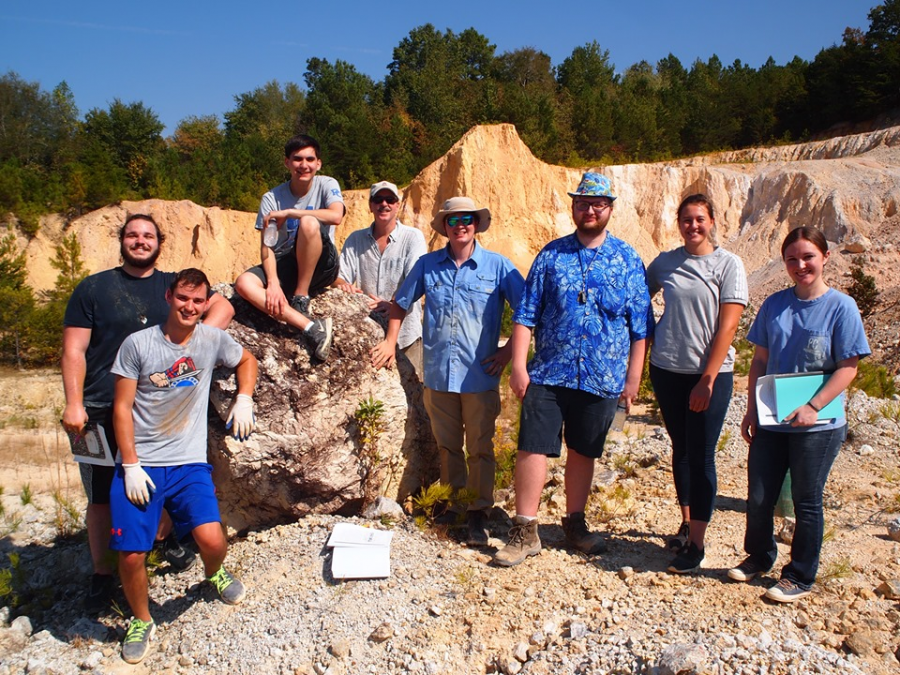A Trip 500 Million Years in the Making
December 13, 2019
This October, Dr. Michael Rischbieter and Mrs. Diane Rischbieter led a group of seven students from Dr. Rischbieter’s Paleontology course on a trip through the ancient history of Alabama. The group searched for a variety of fossils in four different locations, finding the remains of organisms that were over 500 million years old. “It was a unique and amazing experience with great people,” said student Wes Simmons.
The expedition began in a dolomite quarry near Hammondsville, Alabama where the group searched for the fossilized remains of some of Earth’s first photosynthetic organisms. These fossils, called stromatolites, are the remainders of colonies of blue-green algae that grew in layers on top of one another, with each colony growing on the dried remains of the previous one. The stromatolites found in the Alabama quarry dated back approximately 500 million years, but the oldest stromatolites found on Earth are 3.5 billion years old.
This was the first opportunity for the students to be able to actually collect fossils for themselves and the PC collection. “The students were amazed that they were able to step out of the van and collect stromatolites that are nearly a half billion years old […] they are actually quite rare and not all that easy to find, so this was a special treat,” commented Dr. Rischbieter.
The group’s next stop was the Chickamauga limestone, where a large slab of rock on the side of the highway revealed Ordovician cephalopods. These squid-like animals from 450 million years ago could not be extracted from the remains of their ancient sea floor, so they will remain for future paleontologists to see.
Next was a stop in Fort Payne to visit a roadcut that revealed 400 million-year-old limestone. This ancient ocean ecosystem from the Silurian period contained an abundance of invertebrate marine creatures. The most common organisms there were brachiopods; students found mass burials, or “death beds”, filled with the tiny clam-like creatures. Gastropods, the ancestors of today’s snails and slugs, were also in abundance.
Finally, the group spent two days digging in the Mississippian Bangor Limestone in Colbert County. This formation, a steep roadcut made up of chalky white rock, contained an even greater variety of marine invertebrates. Students found even more brachiopods, as well as mollusks and bivalves that were the ancestors of today’s invertebrate sea creatures. Archimedes and fenestrella were plentiful as well; these swirled and net-like fossils were the two body parts of ancient bryozoans, which gave rise to modern filter-feeders. Blastoids, a type of tiny, extinct echinoderm, were difficult but rewarding to find. At a second site in the same formation, the adventurers found a number of small trilobites.
“This was really an amazing group of students,” Dr. Rischbieter said about the experience. “They were constantly on the go, were constantly being exposed to new time periods and different kinds of fossils, and in all cases at each fossil site we stopped at, they were immediately out of the van and immersed in collecting within seconds of arrival.”
Dr. Rischbieter teaches his Paleontology course every Fall semester and leads an expedition to Alabama with each class. Students have the opportunity to visit a variety of fossil sites, including a coal mine from the Carboniferous Period, although this year new ownership of the mine and more strict entrance rules meant that the group could not collect there this year. The groups also stayed with Dr. Jim Lacefield, well-known paleontologist and author of Lost Worlds in Alabama Rocks.
“I highly suggest going if you ever get the opportunity,” said Simmons. “It’s not every day you can go and find something that lived over 300 million years ago and hold it in your own hand.”





